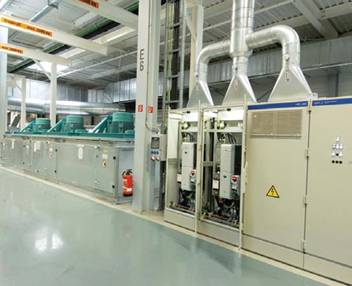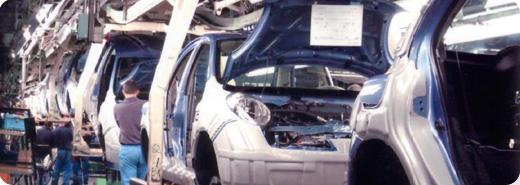


Automotive Industry
For more than 10 years Control Techniques has been applying drives to test applications in the automotive industry. During this time we have supplied equipment to the majority of car manufacturers and Formula 1 teams. Unidrive SP is a high precision drive system that is well adapted to driving automotive test stand equipment.
Unidrive’s integration flexibility is making it the “Spec’d” drive in automobile plants around the world. Whether operating a chassis marriage system, as shown above, or a rolling test rig or wind tunnel, the Unidrive SP has proven itself in automobile and other high technology manufacturing to be a solid and reliable high-performance drive solution.
Typical test applications include:
-
Rolling road dynamometers
-
Engine test stands
-
Transmission test stands
-
Wind tunnels
-
Chassis Marriage Systems
-
Roll & Brake Test Machines
-
Wheel Alignment Systems
-
Headlight Aiming
-
Riveting
-
Sub-assembly Machines
-
Tire Mounting
-
Laser Welding
-
Paint Shop HVAC
Test Rigs
Our engineers can help you to maximize the performance of your test stands. Unidrive SP offers some of the following significant benefits in test stand applications:
-
Real time drive-to-drive network for multi drive synchronization
-
Fast current loop for dynamic test applications
-
Linear torque control within 1% of demand using motor temperature compensation
-
Wide speed range, from 0 - 400Hz in closed loop applications
-
Speed set-point accuracy of 0.001 rpm
-
DC bus and regenerative configurations
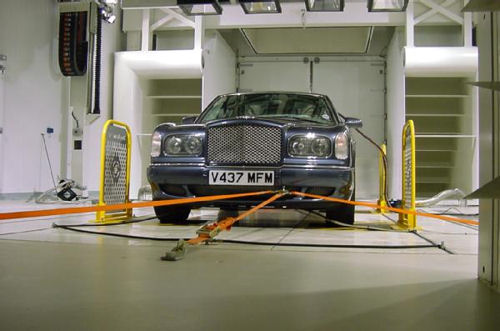
Daimler
Chrysler opts for Control Techniques Drives
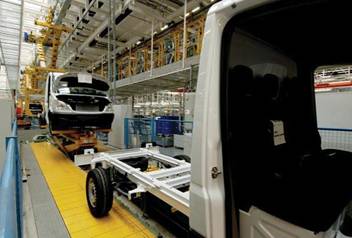
More than 800 AC drives, supplied by the Control Techniques Drive
Centre in Chemnitz have been installed in the new "Sprinter"
production facility in DaimlerChrysler's Ludwigsfelde plant, near
Berlin.
All drives above 1.1 kW used in
the vast, new factory – which was built specifically for a new model
of the Mercedes "Sprinter"
– are supplied by Control Techniques. Why? "Programming
flexibility and openness are the main reasons", says the Technical
Engineer, Mr Wagner. "We had already gained a lot of experience
with Control Techniques Unidrive and Commander SE drives on the "Vaneo"
project", he explained, "and we particularly liked the
Unidrive SP's versatility".
Around 600 Control Techniques
drives were used in the "Vaneo" production facility in
Ludwigsfelde, and production was optimized by direct communication
between PLC's and the drives.
After the decision was made to
produce a new Sprinter model in the Ludwigsfelde plant, Unidrive SP was
specified as the standard for all applications over 1.1 kW. These
included open loop and closed loop applications – for both synchronous
motors and induction motors, and all position-controlled axes in the
entire facility. This embraces a tremendously wide range of different
tasks, from control of conveyor belts, scissor lifts, automated guided
transport vehicles and advanced compact storage systems, up to
ventilation and extraction systems.
Control Techniques drives control
essential functions throughout the three core areas of the facility:
body shop, paint shop and final assembly.
In the body shop, the Sprinter
bodies are built from preformed sheet metal, using welding robots and a
fully-automatic material transport system. Over 200 Unidrive SP drives
are used in this area. They are operated in open loop mode for transport
tasks (in the buffer store, for example, where up to 86 bodyshells are
stored temporarily on eleven rails) and in closed loop mode for hoist
units. A typical precision application can be seen in the automatic
welding cells where two Unidrive SPs, coupled with servo motors are used
in a master/slave configuration for the lifting mechanism, synchronized
with a third Unidrive SP with Unimotor in position control.


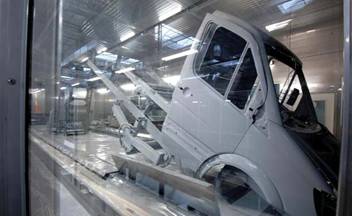
Most of the Unidrive SP drives in
the Ludwigsfelde plant are fitted with an application module for
additional onboard processing and Interbus communication. Profibus DP or
CANOpen bus protocol is used on some axes, this depends on the
particular controller type used. Others have an additional encoder
module to enable a second transmitter signal, from a laser measuring
instrument, for example, to be processed.
Around 200 more drives – rated at up to 110
kW – are used in the Dürr paint shop for ventilation and extraction
tasks. Added to this, a number of blowers and pumps for hydraulic axes
have to be controlled. Most of these drives run in open loop mode, with
Interbus communication links to the corresponding PLCs. Synchronous
motors with resolver feedback to the controlling Unidrive SP drives are
used in the 15-workstation cathodic electro dip coating plant, not only
for forward movement, but also to rotate the body shells within the dip.
In this section, Profibus communication is used for all drives,
including the open-loop elevator drives.
But the most demanding drive applications are
found in the final assembly, where approximately 400 Unidrive SPs are
used, in both open-loop and closed-loop mode.
Each of the open-loop transport units in the
overhead conveyor system is supplied with DC power for its onboard drive
/ motor system via a specially designed busbar system that also enables
CANbus communication. The Unidrive SP drives were installed using
through-panel mounting technology, to keep the control cabinets very
shallow.
Automated guided transport vehicles, used for
carrying components such as the complete power transmission system of a
Sprinter – engine, gearbox, drive shaft and axles - are supplied by
induction from conductors laid in the floor. In addition, the 6 Unidrive
SP inverters (1.1 to 1.5 kW) are supplied at 500 V DC. Two induction
motors are used for movement and steering, whereas two Unimotor type 142
UMD synchronous servo motors are required for the scissor lift, and two
Unimotor type 115 UMD motors for trim. Control signals are picked up
from feed points let into the floor, so the vehicle is instructed when
it should move and which movement profile it should follow. A CANbus/Interbus
gateway is located in the interior of the vehicle and communication with
all six inverters takes place via Interbus.
Two high density storage systems employ
Unidrive SP AC drives for the automated storage / retrieval systems.
A body shell storage facility with 198 positions
over two tracks and four-high racks is used as a call-off point between
the painting and assembly operations, and demands precision movements in
three axes. The axes comprise lifting (55 kW), travelling motion (37 kW)
and lateral motion (2.2 kW) and are all controlled in closed loop mode
with encoder feedback. Additional feedback signals are provided for both
longitudinal and lifting axes – a long-range laser for the distance
along the rail and an absolute encoder fitted on a wheel of the lifting
axis, which both enable monitoring and error correction, where
necessary. Any significant deviation between these signals and the
position feedback at the motor results in a fault trip.
In the small components storage system, around
10,000 different components are accommodated in four magazines. Two
vehicles are used there, each fitted with four Unidrive SP giving 3 axis
servo control (18.5 kW for lifting, 11 kW for longitudinal and lateral
motion) as well as a small, integral 1.5 kW conveyor for the picking
process. Here too, all inverters have an application module for
processing and Interbus communication.
"We like the flexibility and openness of
the Unidrive SP range. It enabled us to use a standard equipment range
for all relevant applications and allowed us to use our own process
expertise in the form of a standard user program".
"To simplify maintenance, we have
restricted ourselves to one make and one type of frequency converter for
all applications over 1.1 kW, and the system was designed to eliminate
long downtimes", says Mr. Wagner, in conclusion. "Our
experience has shown that the Unidrive SP is very reliable and also very
flexible in its configuration."
